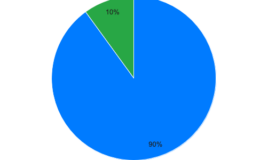I first learned about Disruptive Innovation in the late 90’s after stumbling onto a nascent work by Harvard Business School professor Clayton Christensen, who, in his now-famous work “The Innovator’s Dilemma: The Revolutionary Book That Will Change the Way You Do Business,” detailed how small upstarts often overtake behemoth corporation by starting at the bottom of the market and then moving upstream as the acquire customers, earn revenue and slow eat in the latter’s market share.
Years later, when I worked as a product marketing consultant for small businesses in the sportfishing industry, the then-firmly established theory stared me in the face when I interviewed the owner of a Japanese lure company selling high-end fishing lures in the US for $20 to $50 each at a trade show in Vegas. With anglers buying the lures in droves, it was only a matter of time before competitors followed suit, creating carbon copies of the best sellers, which lead to a market frenzy the industry had never seen.
“I don’t get it,” he said, referring to the competition. “I sell one million lures for $25. They sell 10 to 15 million lures for $5 to $10. I should be copying them.”
Basic math highlights the truth of his words: $25 million < $50 million–$150 million.
A good idea doesn’t mean good for your brand
What looked like an idea — selling more expensive products to eager buyers — sufficed as a blinder to what would become an amazing opportunity: finding a way to sell more low-cost lures. That is, while the Japanese company was taking advantage of what Christensen called sustaining innovation—enhancing existing products—the real innovation was in plain sight be largely ignored: Creating cheaper lures that performed as well or better that the mid-priced and high-end lures, allowing anglers priced out of the market to gain entry and, in the process, grow the size of the pie.
It would be years before the copycat lure manufacturers realized the mistake, but by then a plethora of companies had introduced a smorgasbord of knockoffs. For those of us involved in content marketing, we’re used to scenarios like these. Right?
The competition does something cool or interesting or that gets links, likes, or conversions, and we lose our minds in an attempt to copy them, even if it makes zero sense for us to do so.
Buzzfeed, anyone?

Sure, list posts can be and have been effective, but other than throwing some traffic your way, for most businesses the long-term value simply isn’t there.
But we live in a monkey-see, monkey-do world, so whatever the competition does, we attempt to do it better.
Never mind the fact that (a) we don’t really know how successful they are, or (b) how successful attempting the same tactics will prove for us.
Most important, because our resources are limited, we don’t often see how choosing to chase others’ ideas means we typically cannot adequately focus on the opportunities right in front of us.
Disruptive Innovation can help you identify needle-moving opportunities.
At Mozcon 2015, the word “disruption” kept being spoken by speakers on stage. In fact, a prominent theme of Rand’s opening talk was how a number of prominent brands were willing to disrupt themselves:
- Facebook: The brand’s Little Red Book, given to all employees, contains many useful, guiding tidbits, among them, “If we don’t create the thing that kills Facebook, someone else will.”
- Microsoft: After years of openly expressing contempt for Linux, the brand is welcoming working with the open-source outsider.
Being a huge fan of Disruptive Innovation, hearing Rand talk about this theory made me very proud.
Problem is, what these businesses he described are doing is not really disruption.
In a strict business sense, the examples he shared are known as a pivot, where businesses re-imagine (or refashion) themselves and/or their assets in an entirely different light, as a way to grow, ward off competitors, solve big problems or grow their audience.
What is disruption?
Disruption is something far more significant, especially for brands looking to set themselves apart in competitive markets.

These products start at the bottom, catering to a market that cannot afford the more expensive (and more popular) option. But, as in the case of the lure companies, by focusing on the bottom of the market, there is less competition and greater numbers who can afford the product.
One of the most prominent and most vivid examples of disruptive innovation is how smartphones disrupted the laptop market, which in the 1980s disrupted the desktop market, which itself disrupted the mainframe computer.
Disruptors enter the market at the bottom, where people or industries are being underserved, which is a result of the major players in a vertical choosing to go upstream and over-serve the market, often through added features and benefits people cannot use and don’t need.
But while they continue to cater to the high end of the market, disruptors slide in and gobble up market share at the bottom, before moving upstream to challenge their biggest competitors as the former’s products or services improve in quality, grow in popularity, and suffice as a viable option for even those with more discerning taste.
Why should content marketers care?
For those of you wondering what any of this has to do with content marketing, I say “plenty.” Think about the biggest challenges currently weighing down content marketing, beginning with brands…
- Laboring to create engaging content
- Failing to to understand their audience and their needs
- Lacking clarity on which metrics to use in determining the success of their marketing efforts
I’m convinced this occurs because brands are too focused on better serving audiences they neither own nor enjoy the full support of, instead of looking for the next opportunity on the horizon. Or they’re too focused on ideas, instead of opportunities.
Finding your brand’s disruptive opportunity means you’re not competing in the same sandbox as everyone else, which means your chances of dominating the category are much, much higher.
You can read the entire post on the Moz Blog.






